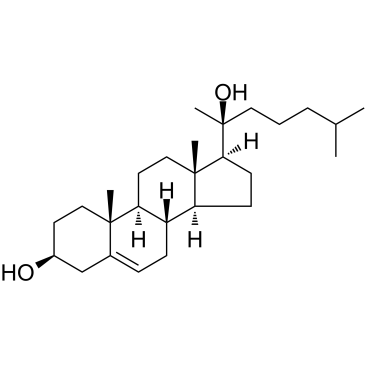Heterogeneous pools of cholesterol side-chain cleavage activity in adrenal mitochondria from ACTH-treated rats: differential responses to different reducing precursors.
B C McNamara, C R Jefcoate
文献索引:Mol. Cell. Endocrinol. 73(2-3) , 123-34, (1990)
全文:HTML全文
摘要
Side-chain cleavage (SCC) of endogenous cholesterol in adrenal mitochondria isolated from ACTH-treated rats indicates that the size of the reactive cholesterol pool depends on the reducing precursor. At optimal concentrations of reductant, this pool was typically at least 2 times greater for isocitrate than for succinate. Succinate-supported reactions were rapidly completed, were highly sensitive to a 2-min preincubation, and failed to deplete spectrally detected P-450SCC-cholesterol complexes. Cholesterol SCC with 1 mM isocitrate exhibited 2-3 times more fast-phase metabolism, a pronounced slow phase, insensitivity to preincubation, and 60% depletion of spectrally detected cholesterol-P-450SCC complexes. Addition of bovine serum albumin (BSA) and EDTA, either during homogenization or directly to the incubation, prevented preincubation losses in response to succinate and removed most of the difference between succinate and isocitrate activities. This effect of BSA/EDTA was reversed within 5 min by octanoate by a mechanism that was enhanced by Ca2+. These distinct reductant characteristics suggest that only a subpopulation of mitochondria or of pools of activity within individual mitochondria can support cholesterol SCC with succinate while isocitrate is necessary for the remainder. The rapid responses of succinate-supported metabolism to preincubation or to octanoate suggest depletion of a critical factor for cholesterol metabolism. Metabolism of added 20 alpha-hydroxycholesterol or deoxycorticosterone established that NADPH remained fully available after succinate-supported cholesterol metabolism had stopped or after preincubation. Cessation of pregnenolone formation, therefore, results from a failure to supply cholesterol, not inadequate NADPH. The preincubation effect suggests loss of an energy-dependent component that enhances this supply of cholesterol. One possibility tested was that GTP, an activator of intermembrane cholesterol transfer (Xu et al. (1989) J. Biol. Chem. 264, 17674-17680), was being lost. Added GTP slightly activated succinate-supported pregnenolone production but did not prevent preincubation-induced losses. alpha-Ketoglutarate, which can generate matrix GTP, is an effective reductant that, in combination with succinate, prevents preincubation-induced losses.
相关化合物
| 结构式 | 名称/CAS号 | 分子式 | 全部文献 |
|---|---|---|---|
 |
20Α-羟基胆固醇
CAS:516-72-3 |
C27H46O2 |
|
In vitro osteoinductive effects of hydroxycholesterol on hum...
2014-11-01 [Plast. Reconstr. Surg. 134(5) , 960-8, (2014)] |
|
Conversion of exogenous cholesterol into glycoalkaloids in p...
2013-01-01 [PLoS ONE 8 , e82955, (2013)] |
|
Oxpholipin 11D: an anti-inflammatory peptide that binds chol...
2010-01-01 [PLoS ONE 5 , e10181, (2010)] |
|
Cholesterol side-chain cleavage by mitochondria from the hum...
1992-09-01 [J. Steroid Biochem. Mol. Biol. 42(8) , 883-90, (1992)] |
|
Modulators of the hedgehog signaling pathway.
2010-09-15 [Bioorg. Med. Chem. 18 , 6613-24, (2010)] |